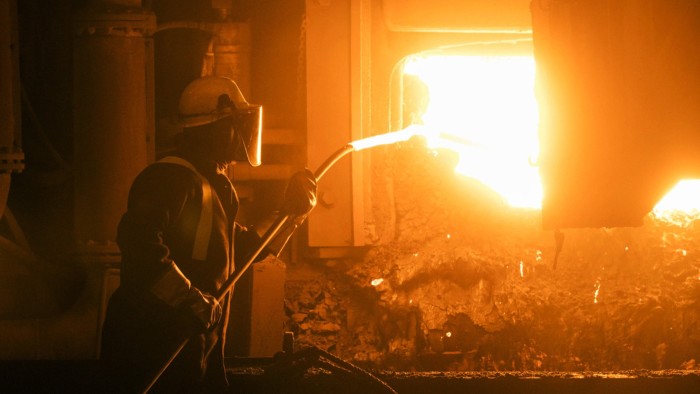Unlock the White House Watch newsletter for free
Your guide to what Trump’s second term means for Washington, business and the world
Steel again. It’s always steel. The proximate cause of Donald Trump’s decision to double steel and aluminium tariffs on Wednesday morning to 50 per cent — one of the few recent duty increases he hasn’t pulled out of — was most likely fury at last week’s federal court ruling against the broader (and wrongly named) “reciprocal” tariffs.
But it’s so familiar for the US — indeed for many governments — to be protecting the sector from imports that steel tariffs are a natural weapon to reach for to signal trade defiance. With some justification, successive US administrations have argued that the long-standing global steel overproduction has worsened and will worsen further because of the impact of Chinese state subsidies. But the US has also displayed so much protectionist bad faith over the industry that, Trump or no, America isn’t the country to fix it.
Steel is a notorious subsidy and trade protection junkie whose habit is hard to break for well-known reasons. Steel production has huge economies of scale which create high barriers to entry; its output is required for tanks and fighter planes as well as railways and bridges; steel mills are frequently located in one-industry towns where plant closures have immediate political salience. In the US, many of the biggest blast furnace operations are located in political swing states and employ workers in well-connected unions.
These factors override the issue that, as an industrial input, increases in price cause widespread damage in manufacturing. There are 80 jobs in downstream industries for every one in steel production.
Broader efforts to promote an international undistorted free market have generally failed. The Organisation for Economic Cooperation and Development set up a steel committee in 1978 for member governments to look at global overcapacity, particularly given Japan’s rise as a producer. It completed its 97th meeting in April with no permanent solution yet found. A high-level “global forum” of the G20 leading economies on steel overcapacity has been similarly ineffectual.
Protectionism is abundant. When the EU recently announced plans to build up its defence and economic resilience, the German steel industry was straight out of the traps demanding fresh handouts. But it’s the American steel industry that has proved particularly inventive over the decades, particularly in its use of “trade remedy” instruments like anti-dumping and anti-subsidy duties on imports. It’s not an obvious exaggeration to say that the single biggest cause of US animus against the World Trade Organization is the WTO’s dispute settlement system repeatedly ruling against a particular methodology known as “zeroing” for calculating anti-dumping duties much used by the US steel industry.
The tariffs that Trump has just doubled were originally imposed during his first term under the so-called “Section 232” legal provision. That procedure requires the administration to show — or at least to assert — a national security imperative, which fails the laugh test but has so far survived domestic legal challenge. Joe Biden’s administration kept the duties in place, albeit suspending them with the EU and other trading partners pending negotiations which never definitively concluded.
Biden’s administration may have been less wantonly destructive but was also highly disingenuous. He tried and failed to use tariffs as leverage to force the EU into a so-called “global arrangement on sustainable steel and aluminium” which would gang up on China, a plan correctly regarded in Brussels as traditional steel protectionism in a new guise.
Trump’s new tariffs create yet more potential for distortion and blackmail. Trump unsuspended the 25 per cent steel tariffs after his second term began, and last month he gave the UK an exemption. The loophole (which has yet to be implemented) occasioned much rejoicing in Britain but a distinct lack of detail about what, apart from some import quotas on beef and bioethanol, it had given in return.
To be fair, the UK has somewhat better reasons to intervene to retain steel production than the US, where the Department of Defense itself said that it did not need the cover of Section 232 to maintain domestic capacity for strategic reasons. The UK is down to a single blast furnace plant which produces steel from ore, as opposed to smaller plants which recycle scrap by melting. Keeping the plant in Scunthorpe open indefinitely is unlikely to be a viable option, but there is a genuine security issue to discuss.
That also makes the UK vulnerable to Trump’s coercion. The tariff loopholes negotiated (though not yet implemented) in last month’s deal were conditional on the UK aligning with the US on supply chain security for steel and aluminium, a provision clearly aimed at China. It remains unclear exactly how the Trump administration will use this leverage given the fresh round of duties.
Domestically, it’s relatively easy and popular to impose steel tariffs, and their political sensitivity abroad has a way of forcing trading partners quickly to the negotiating table. Trump’s trade pathology is uniquely awful, but the fact that it’s routinely transmitted through steel protectionism is no surprise at all.
alan.beattie@ft.com
https://www.ft.com/content/ecc3d0c4-ee69-49f1-a684-d537696133ee


